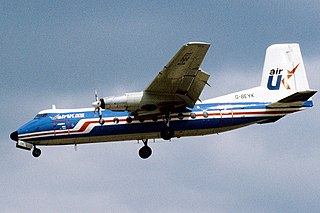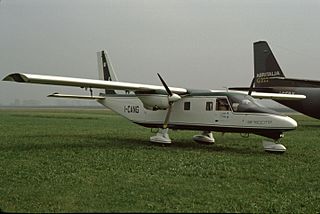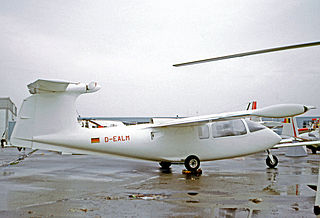The Sukhoi Su-80 is a Russian twin-turboprop, twin-boom STOL transport aircraft.

The Pilatus PC-6 Porter is a single-engined STOL utility aircraft designed by Pilatus Aircraft of Switzerland. First flown in 1959, the PC-6 was produced at Pilatus Flugzeugwerke in Stans, Switzerland. It has been built in both piston engine- and turboprop-powered versions, and was produced under licence for a time by Fairchild Hiller in the United States. After 604 deliveries in 63 years, Pilatus ended production in 2022.

The Curtiss-Wright X-19, company designation Model 200, is an American experimental tiltrotor aircraft of the early 1960s. It was noteworthy for being the last aircraft of any kind manufactured by Curtiss-Wright.

The Embraer EMB 121 Xingu is a twin-turboprop fixed-wing aircraft built by the Brazilian aircraft manufacturer, Embraer. The design is based on the EMB 110 Bandeirante, using its wing and engine design merged with an all-new fuselage. The EMB 121 first flew on 10 October 1976.

The Citabria is a light single-engine, two-seat, fixed conventional gear airplane which entered production in the United States in 1964. Designed for flight training, utility and personal use, it is capable of sustaining aerobatic stresses from +5g to -2g. Its name, "airbatic" backwards, reflects this.

The Handley Page HPR.7 Dart Herald is a British turboprop passenger aircraft, designed in the 1950s as a DC-3 replacement, but only entering service in the 1960s by which time it faced stiff competition from Fokker and Avro. Sales were disappointing, contributing in part to the demise of Handley Page in 1970.

The Gavilán 358 is a Colombian light utility transport aircraft of the 1990s. A high-winged monoplane powered by a piston engine, small numbers of Gaviláns were produced in the late 1990s/early 2000s, some serving with the Colombian Air Force.

The type designation Dornier Do 28 comprises two different twin-engine STOL utility aircraft, manufactured by Dornier Flugzeugbau GmbH. Most of them served with the German Air Force and Marineflieger and other air forces around the world in the communications and utility role. The Do 28 series consists of the fundamentally different Do 28 A/B (1959) and Do 28 D Skyservant (1966).

The Piel CP-30 Emeraude is an aircraft designed in France in the mid-1950s and widely built both by factories and homebuilders.

The Vulcanair SF.600 Canguro was a feederliner developed in Italy in the late 1970s. Despite a number of attempts to put the aircraft into series production, only a small number were ever built. The Canguro was a high-wing cantilever monoplane of conventional configuration with a fuselage of rectangular cross-section and a high-set tail. The tricycle undercarriage was not retractable, and its main units were carried on sponsons on the fuselage sides. SIAI Marchetti provided funding towards the construction of the prototype, and constructed this aircraft at the former Aviamilano plant. After flight testing proved positive, the type was put on sale, but failed to attract buyers in any number, even when the original piston engines were exchanged for turboprops and retractable undercarriage was offered as an option.

The Angel Aircraft Corporation Model 44 Angel is a twin-engine STOL utility aircraft produced in the United States since the mid-1990s. Designed by Carl Mortenson and The King's Engineering Fellowship to be well-suited for missionary work from remote locations around the world, it is a low-wing cantilever monoplane with a retractable tricycle undercarriage and eight seats. The design is largely conventional, with the exception that the engine nacelles are mounted on top of the wings in a pusher configuration. Construction is aluminum throughout the airframe.
The LAPAN XT-400,, was a twin-engine STOL utility aircraft under development by the government of Indonesia in the late 1970s into the early 1980s. The programme was cancelled without the prototype having been completed or flown. It was to have provided passenger and cargo transport from rough and unprepared fields, with secondary roles as an aerial survey platform and air ambulance.

The Malmö MFI-10 Vipan was a four-seat light utility monoplane designed and built in Sweden by Malmö Flygindustri. Only three aircraft were built and the type did not enter quantity production.

The Maule M-7 is a family of single-engine light aircraft that has been manufactured in the United States since the mid-1980s.

The Piel CP.70 Beryl is a French twin-seat, single-engine sport aircraft designed by Claude Piel. It was first flown in France in the 1960s and marketed for amateur construction.
The Hongdu N-5,, originally known as the Nanchang N-5, is a Chinese agricultural aircraft. First flown in 1989, and entering into production in 1992, the N-5 is a single-engined low-wing monoplane, and is available in versions powered by a piston engine or a turboprop.

The Robin R 3000 is a French single-engined light aircraft designed and built by Avions Robin, which entered production in the 1980s.

The Pöschel Equator was a single engine, 6/8 seat amphibious aircraft built in the 1970s featuring glass-fibre covered fuselage. Three aircraft were built, each with different engine or wing positions, but no production followed.

The Taylorcraft F22 is a two-seat American light aircraft produced in small numbers by Taylorcraft in the late 1980s and early 1990s. It is a further development of the Taylorcraft F-19 via the F-21 design. Manufacturing and marketing of the F22 was halted by the financial difficulties of Taylorcraft, although plans to restart production existed in 2007.
The Aircorp B2-N Bushmaster is a prototype Australian light aircraft designed for aerobatic, touring, and utility use. It first flew in 1989 and did not enter production.
















